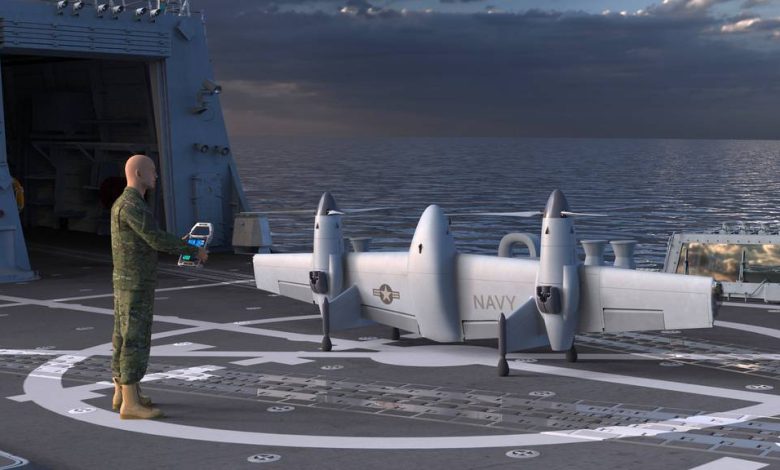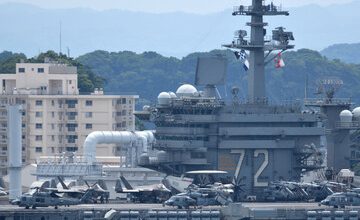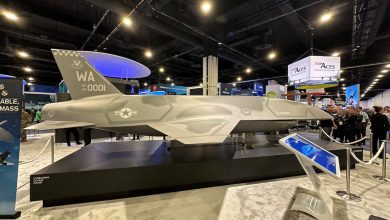DARPA picks six firms to develop experimental ship-launched drones

The Defense Advanced Research and Projects Agency has chosen six companies to move forward on an experimental, low-weight drone that can take off and land vertically from a ship.
The companies DARPA selected for its ANCILLARY program — also known as the Advanced Aircraft Infrastructure-Less Launch and Recovery program — include a mix of major defense contractors and smaller aeronautics companies. AeroVironment, Griffon Aerospace, Karem Aircraft, Method Aeronautics, Northrop Grumman, and Lockheed Martin’s Sikorsky will now further develop and refine their proposed ANCILLARY designs.
DARPA wants ANCILLARY to lead to a future drone that can one day be deployed and retrieved from Navy ships without large mechanical launchers or landing and recovery equipment. These drones could carry cargo, conduct intelligence, surveillance and reconnaissance missions, and track and target enemies beyond a ship’s line of sight, DARPA said.
These small drones must be able to take off and land like a helicopter from the flight decks of ships or rough surfaces in most weather conditions, and then fly missions like a winged aircraft, DARPA said. It also must be able to carry large payloads and fly for long distances when needed.
“The goal of ANCILLARY is to increase small vertical takeoff-and-landing uncrewed aerial system [or UAS] capabilities by a factor of three over the current state-of-the-art flying today,” DARPA program manager Steve Komadina said in a statement. “Our performers are searching for innovative ways to increase payload weight and range [and] endurance of small, ship-launched UAS by means of novel configurations, propulsion, and controls while also removing the need for special infrastructure.”
Komadina said the Navy and Marine Corps would be most likely to use this technology, but it could also be useful for the Army, Air Force, Coast Guard, and U.S. Special Operations Command.
In June 2023, DARPA picked nine companies to pitch their initial concepts for ANCILLARY, before now whittling the list down to six. Those firms will now enter a 10-month phase in which they try to reduce the risks on their design, and conduct hover testing of elements of their proposed aircraft. Once this phase is finished, the companies will submit proposals to move on to the next phase, which will include fabrication and flight testing.
Formal flight tests of the overall design are expected to start in early 2026, DARPA said.
Christopher Harris, the program manager for Northrop’s ANCILLARY effort, said in an interview the company is incorporating its work on autonomous capabilities, vertical takeoff and landing and long-endurance aircraft design for its ANCILLARY pitch.
Pulling together an aircraft that can carry out the kind of endurance requirements DARPA set, without needing launch and recovery infrastructure, is challenging, Harris said May 24.
Northrop’s aircraft will be able to carry payloads of 60 pounds, and fly a range of 100 nautical miles for up to 20 hours. The company’s version of ANCILLARY will use a pair of rotors to take off and land, and another rotor as a propeller to fly forward, he said.
ANCILLARY will be able to take off and land from a ship in adverse sea conditions, and operate in highly contested environments, Harris said. And it could help with logistics by helping unload a ship and moving cargo to shore. Northrop is incorporating its work on autonomous capabilities, vertical takeoff and landing and long-endurance aircraft design for its ANCILLARY pitch, Harris said.
“We have a wide array of supplier awareness, we have our own innovative technologies, and we have a team that we think is uniquely capable to deliver what DARPA is asking for here,” he said.
Sikorsky said Wednesday it is conducting flight tests on its version of ANCILLARY. The company refers to its design as a “rotor blown wing,” which sits upright on its tail to take off like a helicopter, then transitions to horizontal forward flight.
Sikorsky said such a design will reduce drag on the wing when the aircraft is hovering and shifting to forward flight, and result in better efficiency and endurance when cruising.
“Flight tests are under way to verify our tail-sitting rotor blown wing UAS can launch and land vertically with high stability, and cruise efficiently on wing,” Igor Cherepinsky, director of Sikorsky Innovations, the company’s rapid prototyping group.
Cherepinsky said the articulated rotor system in Sikorsky’s version of ANCILLARY is similar to a traditional helicopter’s rotors, and the aircraft will use Lockheed’s autonomous MATRIX technology in its flight controls.
Sikorsky’s aircraft now in flight tests is powered by a battery, but the company plans to build a 300-pound hybrid electric version if it is selected to continue on the program. That aircraft would carry a 60-pound ISR payload, the company said.
Method Aeronautics said in a statement that it is working with Sierra Nevada Corp., which has a background in landing systems an aircraft modification and integration, and Bechamo on this project. Bechamo is a company that specializes in using artificial intelligence to create aircraft flight controls.
“Method’s design brings a novel approach enabling efficient, robust VTOL [vertical takeoff-and-landing] capability for Group 3 UAS,” Method said in a statement. “Method sees this program as critical technology development to enable wider use of VTOL UAS by U.S. forces abroad, and is actively working to accelerate development beyond the scope of the award.”
Group 3 drones are under 1,320 pounds and fly at speeds of up to 250 knots.
Statements from AeroVironment, Griffon and Karem were not immediately available.
Stephen Losey is the air warfare reporter for Defense News. He previously covered leadership and personnel issues at Air Force Times, and the Pentagon, special operations and air warfare at Military.com. He has traveled to the Middle East to cover U.S. Air Force operations.







